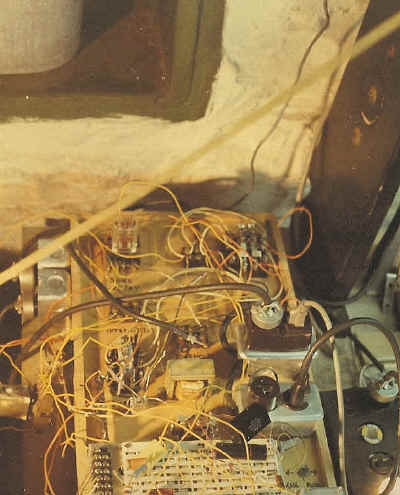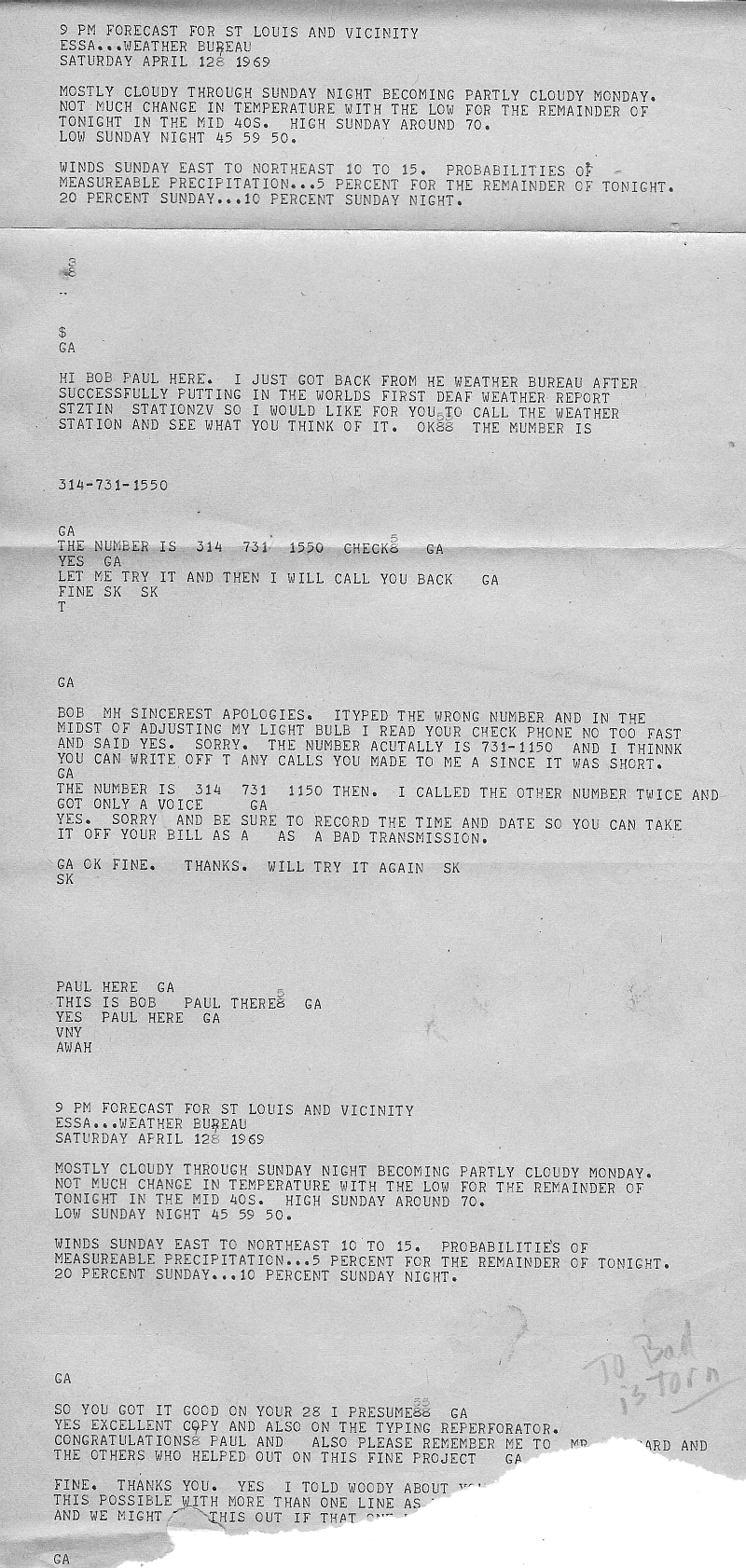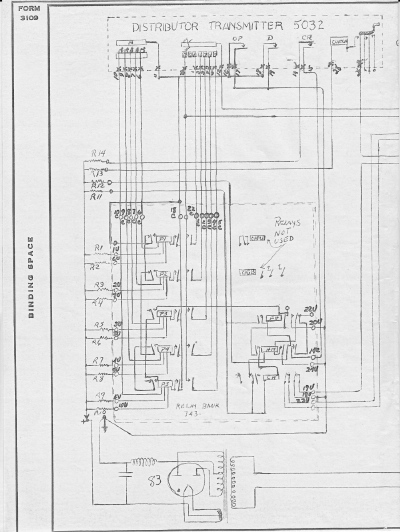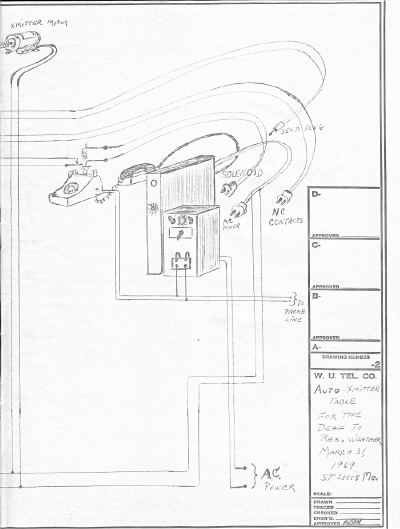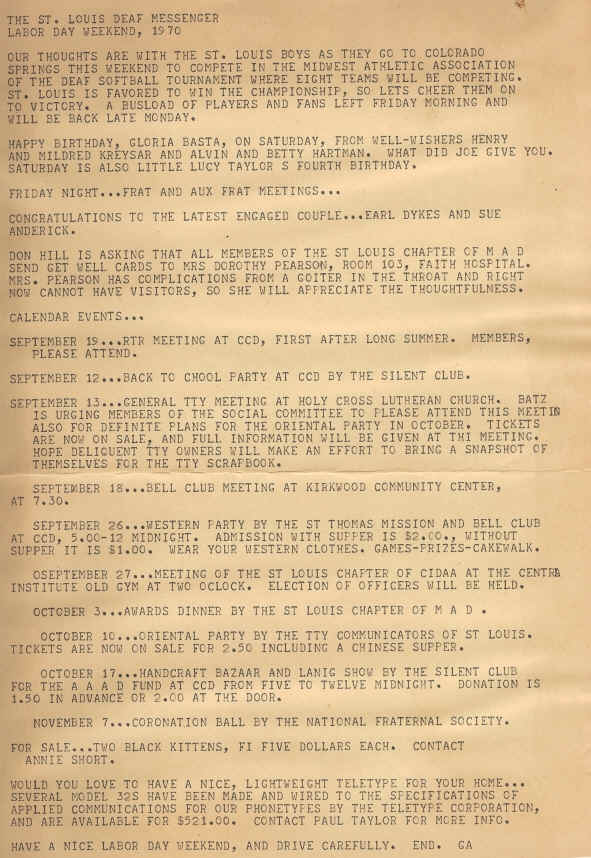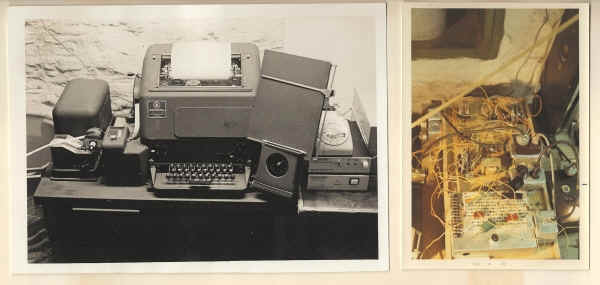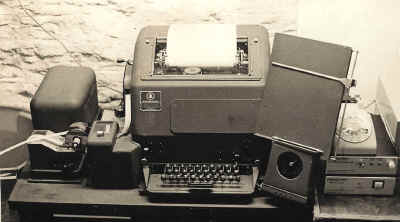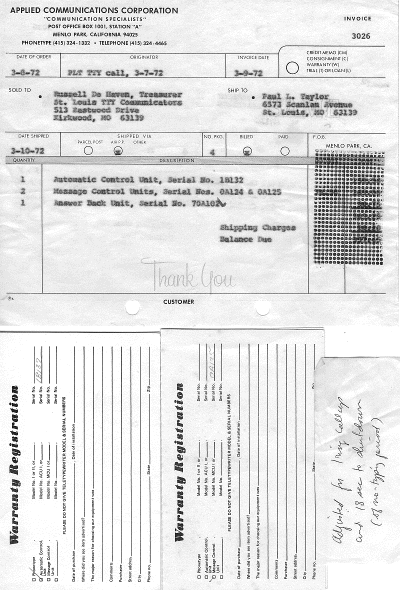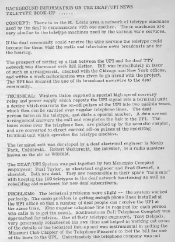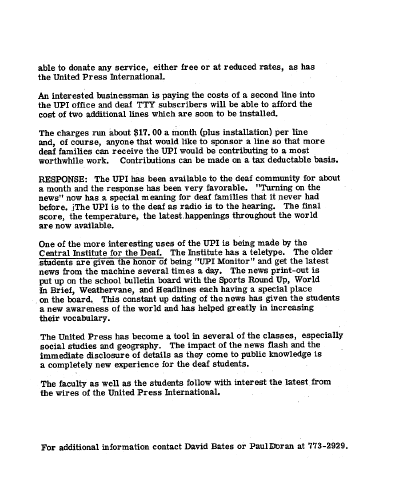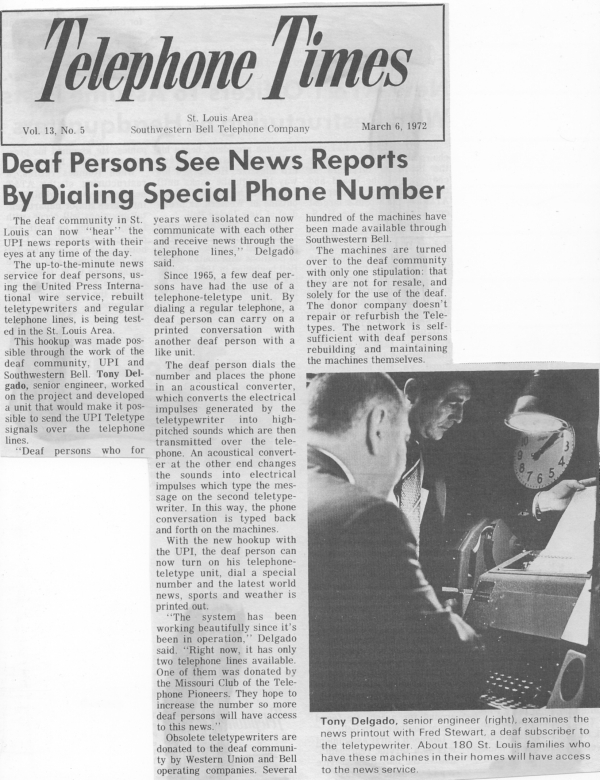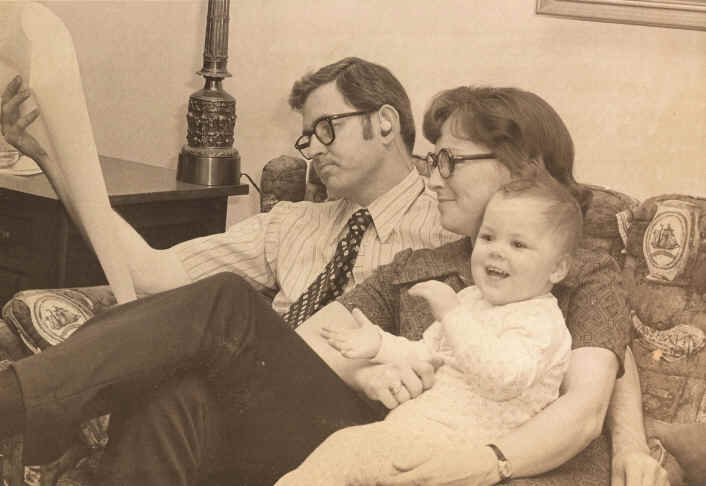|
TTY News Services Over Phone Lines and Message Services |
||||||||||
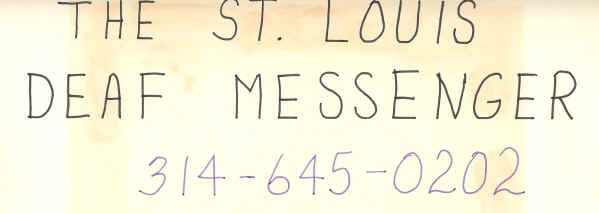
From the Paul and Sally Taylor Collection at SMECC
Ed Sharpe asks Paul Taylor how the controller pictured
above functioned.
Paul state "Golly, that was some 40 years ago. I'm still not sure just what it does exactly but I get the feeling it was built to accept a phone call from a distant TTY. Something like on the first ring, it would turn on the punched paper tape reader and send the contents of the tape (announcements, news, deaf gatherings, where and time of meeting, etc) to the receiver. All that information would be printed on the originator's TTY paper. Then at the end of the loop, the tape would stop and the TTY printer would come on to receive a typed message the originator wanted to send like "thanks" or corrections if the sent information did not have the right date or time of a meeting or whatever.
The electronics is simple, really. A relay would be used to turn on the
punched tape reader on the first telephone ring. Also the same relay at
the same time would connect the telephone to the modem and the modem
would send tones over the telephone line, etc. At the end of the tape, a
special code maybe all five punched Baudot code holes would signal the
tape reader to stop and turn on the TTY printer adjacent to the tape
reader to receive whatever replies would come from the originator. After
a quiet period like 15 seconds if the TTY printer does not print, then
the whole unit shuts down for the next caller. The phone company as I
remember had those special relays and switches, etc and are available
from the maintenance shop in the phone company. The telephone servicemen
knew me well and it was no problem getting those special relays.
Maybe this helps ? Paul"
MORE!--------
The Deaf Messenger was built (or rather fabricated) using relays and
the punched tape reader. Sally would type on the paper tape the weekly
news and what's going on in the Deaf community . The tape would be
some 12 to 20 feet long depending on the amount of news. After she's
done, the ends of the tape were taped so that you have a tape loop. At
the end of the news, there would be a 'V" cut out so the electric
eye would sense the end of the tape and signal to the tape reader to
shut off. Then the teletype would come on to receive comments from the
viewers . After a period of quiet time, like fifteen seconds, the
teletype and Phonetype were automatically turned off and the phone
relay contacts were closed effectively hanging up the phone for the
next call. Yes, I built all that and it wasn't too difficult as much
of the devices were from the laboratories at Monsanto Chemical where I
worked. It was around the year 1972. I remember how popular the Deaf
Messenger was as it received many messages each week. Many of the Deaf
events throughout St. Louis were advertised on each caller's teletype
and made it possible for many people to know what events would come in
the next week or two. At that time there were some 75 to 100 teletypes
in the Deaf people's homes throughout St. Louis and across the river
in Illinois. A tremendous jump in communications for the Deaf
community where messages were conveyed only by postal mail and
personal eye to eye contacts. A truly exciting event for everyone !!
The Deaf Messenger was located in our basement near the photo
darkroom. It was especially busy during the evenings and weekends when
everyone was at home. Sally and I would remark often how many times
the messenger turned on and off each evening. David, our son, was
about 7 years old that time and he would smile each time he heard the
messenger came on.
What fun it was !! Nothing like it.
Paul
From the Paul and Sally Taylor Collection at SMECC In the above message there are weather reports but more important is the historic invitation from Paul Taylor to Robert Weitbrecht to try the weather bureau line for the deaf to use. Robert asked to be remembered to Mr. Woodward ( AKA WOODY) near the torn section of this TTY message.
From the Paul and Sally Taylor Collection at SMECC
From the Paul and Sally Taylor Collection at SMECC
---------------------------------------------------------------------------------------------------------------------------
From - From the Paul and Sally Taylor Collection at SMECC Proceedings of the Gallaudet College Washington, D.C. Published by
Appendix H NEWS SERVICE N.Y.- N.J. NEWS CENTER 201-796-DEAF (201-796-3323) By: Lee Brody I had admired the deaf messengers of Boston and Washington, D.C. and I received many helpful suggestions and schematics on how to build one for the N.Y.- N.J. area. However I was at a disadvantage. I couldn't understand the technology on how to build one nor did I have the time to learn, so I hired three different professional TTY technicians to build one for me. The first news service was somewhat similar to the Boston deaf messenger which consisted of a Apcom modem, Apcom automatic control unit, two M14 transmitters, one M14 reperforator, and four DPDT relays. All of this equipment was stacked on top of each other onto one M15 table. This system was started up by using the function Bell switch in the M14 reperforator when the key upper case "s" was pressed. The first tape announced the station and date then it stopped on sensing a blank character to place the apparatus into position for receiving the callers message or news contribution. Then the caller would press upper case "s" to start up the second tape which contains the N.Y.- N.J. News.This system was in operation for several months and proved to be unreliable. It was too easy for the caller to accidentally trip off the second tape when the upper case "S" was pressed during the course of typing in a news contribution. There were complaints that either too much news was left out or the tape message was too long. Soon the novelty of calling the news center wore off and the number of callers dropped drastically. The second news service apparatus now in operation, consists of six M28 tape transmitters, one M28 KSR printer, one Wheelock relay, seven relays, one idle line control unit and one Essco modem. (Figure 1) This news service was designed to work with any modem that may come into the PTTY network. In this way, new modem designs could be tested for compatibility. The automatic control unit was built at a cost of $25.00 by using readily available components. A "Figs" and "H" at the end of the tape caused the motor stop control to stop the TD and the M28 printer. The stunt box of the M28 printer controlled the selection of the tape message. A "carriage return" and "line feed" in the beginning of the tape placed the stunt box in a non-select position so that the news contents could not trip off another TD. Six DPDT relays that came from discarded equipment control the six TD's. All the other TD's are disconnected when one TD is running so that it is impossible for two TD's to be running at the same time. The idle line control unit that came from discards of printers causes the News Center to shut down after one minute if there is no signal on the keyboard loop. The news service is ready for the next caller. The Wheelock signal relay is activated when the phone rings and closes another relay that electrically "takes the phone off the hook" and turns on the modem and news service. The phone handset is left in the modem cradle at all times.
Each tape is designed to be approximately five minutes and to appeal to a wider diversity of callers. The test tape is used when a new PTTY station is installed. The installer tests the performance of the printer, modem and telephone lines while he resets the range finder to optimum performance. Pictures are sent on the news service so that children may color them with crayons. Bulletins from other news centers, clubs, or a radio are on a separate tape for the interested caller. There are several other spare contacts in the stunt box for future additional services. One stunt is for a TTY time clock that announces the time in GMT in the beginning and end of each tape message. One stunt is a special code addressed to members of the N.Y.- N.J. PTTY committee. Mounted next to this news center equipment we have a complete radio-TTY receiving station still in experimental stages. This consists of four radio receivers (3-R390A and l-75S3C), four RTTY converters (TTL-2 and ST6 and CV57 with TT-63 and CFA-l), five radio antennas, and four M28-three speed reperforators. (Figure 2) Each converter is controlled by a time clock and solenoids. The radio news bulletins may be played through the news center completely automatically upon selection of the stunt box. We are experimenting with two types of RTTY messages. One is a tape loop that has been re-edited and the other is "live" news straight from the radio. When this RTTY system has been perfected and all legal requirements have been met, then this equipment will be part of the N.Y.- N.J. PTTY News Center. The third news service apparatus is still under construction. It is a dual audio tape recorder system with a telephone answering service and a two tone remote control transmitter. To make it suitable for PTTY the entire device has to be custom made with a high precision motor drive. This equipment will be placed in different parts of the state in N.Y. and N.J. This equipment is quite compact and can be placed unobtrusively in someone's apartment. Callers to the News Center need only to call the nearest news station to get the N.Y.- N.J. news which would be the same news throughout the state and toll free. The main News center calls each of these audio tape recorder stations and sends a certain tone on the phone lines. This certain tone places the recorder into "record" mode and then the PTTY message is transmitted. A different tone places the recorder back into "playback" mode ready for individual callers. With this method several callers would receive the same message at the same time at lower phone rates. Important announcements such as a storm warning or details of funeral arrangements can be quickly dispatched. When this audio type news service is in operation, we will publish more details.
From the Paul and Sally Taylor Collection at SMECC |
||||||||||
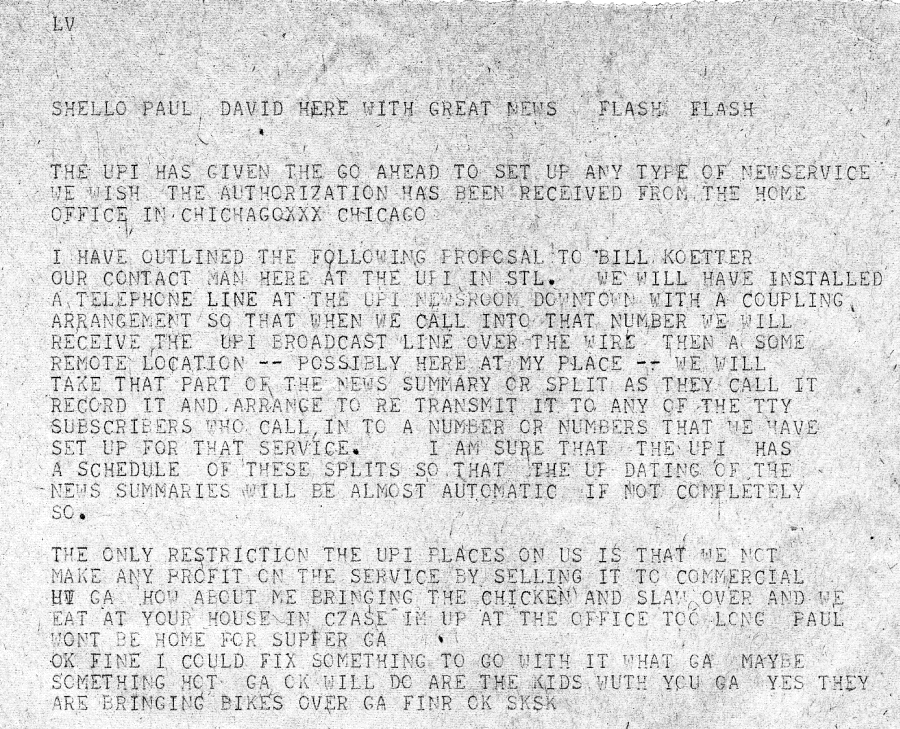
From the Paul and Sally Taylor Collection at SMECC |
||||||||||
|
From the Paul and Sally Taylor Collection at SMECC
From the Paul and Sally Taylor Collection at SMECC Paul and Sally Taylor pause to
read the news off the St Louis Deaf Messenger broadcast on the
Teletype
|
